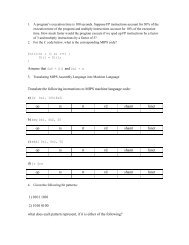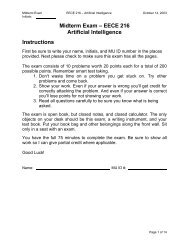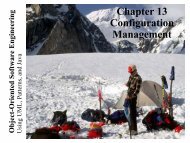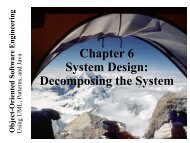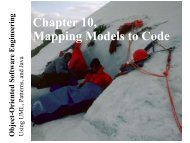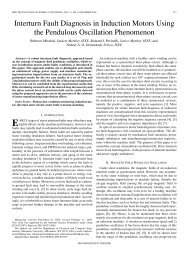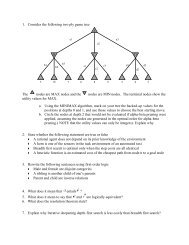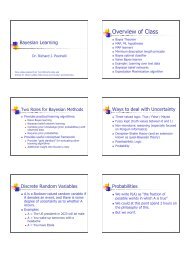A Comparison of Decision Tree Ensemble Creation Techniques Ç
A Comparison of Decision Tree Ensemble Creation Techniques Ç
A Comparison of Decision Tree Ensemble Creation Techniques Ç
You also want an ePaper? Increase the reach of your titles
YUMPU automatically turns print PDFs into web optimized ePapers that Google loves.
174 IEEE TRANSACTIONS ON PATTERN ANALYSIS AND MACHINE INTELLIGENCE, VOL. 29, NO. 1, JANUARY 2007TABLE 1Selected Aspects <strong>of</strong> This Work Compared with Previous Worksavailable features is randomly selected and the best split availablewithin those features is selected for that node. Also, bagging is usedto create the training set <strong>of</strong> data items for each individual tree. Thenumber <strong>of</strong> features randomly chosen (from n total) at each node is aparameter <strong>of</strong> this approach. Following [6], we considered versions<strong>of</strong> random forests created with random subsets <strong>of</strong> size 1, 2, andblog 2 ðnÞþ1c. Breiman reported on experiments with 20 data sets, inwhich each data set was randomly split 100 times into 90 percent fortraining and 10 percent for testing. <strong>Ensemble</strong>s <strong>of</strong> size 50 werecreated for Adaboost and ensembles <strong>of</strong> size 100 were created forrandom forests, except for the zip code data set, for whichensembles <strong>of</strong> size 200 were created. Accuracy results were averagedover the 100 train-test splits. The random forest with a singleattribute randomly chosen at each node was better than AdaBooston 11 <strong>of</strong> the 20 data sets. The random forest with blog 2 ðnÞþ1cattributes was better than AdaBoost on 14 <strong>of</strong> the 20 data sets. Theresults were not evaluated for statistical significance.Dietterich introduced an approach that he termed randomizedC4.5 [7]. We will refer to this more generally as random trees. Inthis approach, at each node in the decision tree, the 20 best tests aredetermined and one <strong>of</strong> them is randomly selected for use at thatnode. With continuous attributes, it is possible that multiple testsfrom the same attribute will be in the top 20. Dietterich reported onexperiments with 33 data sets from the UC Irvine repository. Forall but three <strong>of</strong> the data sets, a 10-fold cross-validation approachwas followed. The other three used a train/test split as included inthe distribution <strong>of</strong> the data set. Random tree ensembles werecreated using both unpruned and pruned (with certainty factor 10)trees, and the better <strong>of</strong> the two was manually selected forcomparison against bagging. Differences in accuracy were testedfor statistical significance at the 95 percent level. With thisapproach, it was found that randomized C4.5 resulted in betteraccuracy than bagging six times, worse performance three times,and was not statistically significantly different 24 times.Freund and Schapire introduced a boosting algorithm [3] forincremental refinement <strong>of</strong> an ensemble by emphasizing hard-toclassifydata examples. This algorithm, referred to as AdaBoost.M1,creates classifiers using a training set with weights assigned to everyexample. Examples that are incorrectly classified by a classifier aregiven an increased weight for the next iteration. Freund andSchapire showed that boosting was <strong>of</strong>ten more accurate thanbagging when using a nearest neighbor algorithm as the baseclassifier, though this margin was significantly diminished whenusing C4.5. Results were reported for 27 data sets, comparing theperformance <strong>of</strong> boosting with that <strong>of</strong> bagging using C4.5 as the baseclassifier. The same ensemble size <strong>of</strong> 100 was used for boosting andbagging. In general, 10-fold cross-validation was done, repeated for10 trials, and average error rate reported. For data sets with adefined test set, an average <strong>of</strong> 20 trials was used with this test set.Boosting resulted in higher accuracy than bagging on 13 <strong>of</strong> the27 data sets, bagging resulted in higher accuracy than boosting on10 data sets, and there were 4 ties. The differences in accuracy werenot evaluated for statistical significance.Table 1 shows a comparative summary <strong>of</strong> experiments andresults <strong>of</strong> this work with the previously discussed work.3 EXPERIMENTAL DESIGNIn this work, we used the free open source s<strong>of</strong>tware package“OpenDT” [13] for learning decision trees in parallel. This programhas the ability to output trees very similar to C4.5 release 8 [14], buthas added functionality for ensemble creation. In OpenDT, likeC4.5, a penalty is assessed to the information gain <strong>of</strong> a continuousattribute with many potential splits. In the event that the attributeset randomly chosen provides a “negative” information gain, ourapproach is to randomly rechoose attributes until a positiveinformation gain is obtained, or no further split is possible. Thisenables each test to improve the purity <strong>of</strong> the resultant leaves. Thisapproach was also used in the WEKA system [15].As AdaBoost.M1 was designed for binary classes, we use asimple extension to this algorithm called AdaBoost.M1W [2] whichmodifies the stopping criteria and weight update mechanism todeal with multiple classes and weak learning algorithms. Ourboosting algorithm uses a weighted random sampling withreplacement from the initial training set, which is different froma boosting-by-weighting approach where the information gain isadjusted according to the weight <strong>of</strong> the examples. Freund andSchapire used boosting-by-resampling in [3]. There appears to beno accuracy advantage for boosting-by-resampling or boosting-byreweighting[16], [17], [18] though Breiman reports increasedaccuracy for boosting-by-resampling when using unpruned trees[19]. We use unpruned trees because <strong>of</strong> this and, in general, forincreased ensemble diversity [20]. Boosting-by-resampling maytake longer to converge than boosting-by-reweighting though.We have made a modification to the randomized C4.5 ensemblecreation method in which only the best test from each attribute is
IEEE TRANSACTIONS ON PATTERN ANALYSIS AND MACHINE INTELLIGENCE, VOL. 29, NO. 1, JANUARY 2007 175TABLE 2Description <strong>of</strong> Data Sets Attributes and Sizeallowed to be among the best set <strong>of</strong> 20 tests, from which one israndomly chosen. This allows the algorithm to be less prejudicedagainst discrete attributes when there are a large number <strong>of</strong>continuous valued attributes. We call it the “random trees B”approach. For this approach, we used a random test from the20 attributes with maximal information gain.In the random subspace approach, half ðdn=2eÞ <strong>of</strong> the attributeswere chosen each time. For the random forest approach, we used asingle attribute, two attributes, and blog 2 n þ 1c attributes (whichwill be abbreviated as random forests-lg in the following).Fifty-seven data sets were used, 52 from the UC Irvine repository[21], credit-g from NIAAD (www.liacc.up.pt/ML), phoneme fromthe ELENA project (ftp.dice.ucl.ac.be/pub/neural-nets/ELENA/databases), and several synthetic data sets from Breiman for whichsource code may be found with the Delve package (http://www.cs.utoronto.ca/~delve/data/datasets.html). The data sets,described in Table 2, have from 4 to 256 attributes and the attributesare a mixture <strong>of</strong> continuous and nominal values.3.1 ExperimentsFor each data set, a stratified 10-fold cross-validation wasperformed. A stratified n-fold cross-validation breaks the data setinto n disjoint subsets each with a class distribution approximatingthat <strong>of</strong> the original data set. For each <strong>of</strong> the n folds, an ensemble istrained using n 1 <strong>of</strong> the subsets, and evaluated on the held outsubset. As this creates n nonoverlapping test sets, it allows forstatistical comparisons between approaches to be made.For each data set, we also performed a set <strong>of</strong> five stratified tw<strong>of</strong>oldcross-validations. In this methodology, the data set is randomlybroken into two halves. One half is used in training and the other intesting and vice versa. This validation is repeated five times, eachwith a new half/half partition. Dietterich’s experiments used a t testto evaluate statistical significance [8]. In Alpaydin’s method, thet test is abandoned in favor <strong>of</strong> an F test for reasons <strong>of</strong> stability [9].Specifically, rather than using the difference <strong>of</strong> only one test set, thedifference <strong>of</strong> each test set is considered in the F test used here.For each approach we use 1,000 trees in our ensemble, thoughwe examine boosting with both 50 and 1,000 trees. Breiman <strong>of</strong>tenused only 50 trees in his research [1], [6], and Schapire has used asmany as 1,000 [22].3.2 Statistical TestsWe used three approaches to testing the statistical significance <strong>of</strong>the observed differences in accuracy. One approach is a t test onthe results <strong>of</strong> a 10-fold cross-validation. This is the most widelyused approach for this type <strong>of</strong> experiment. While the 10 folds <strong>of</strong> thecross-validation have independent test sets, the training data ishighly overlapped across folds, and use <strong>of</strong> the t test assumesindependent trials. Dietterich points out that this results in anelevated level <strong>of</strong> Type I error, which can be corrected for by his5 2 cross-validation. This relies on the idea that learning curvesrarely cross for algorithms as training set size varies.We applied the Bonferroni correction, a calculation which raisedthe critical value necessary for determining significance, in order tocompensate for the number <strong>of</strong> methods used in our experiments. Inthe Bonferroni correction, the value <strong>of</strong> an entire set <strong>of</strong>n comparisons is adjusted by taking the value <strong>of</strong> each individualtest as =n [23]. In our experiments, we define ¼ 0:05 and n ¼ 7.Inthe case <strong>of</strong> the 10-fold cross-validation, the t-critical value is 3.47 andfor the 5 2-fold cross-validation, the F-critical value is 11.66.A recent paper [10] suggests that the best way to comparemultiple algorithms across multiple data sets is to compare theiraverage ranks. In our case, one could rank the algorithm by averageaccuracy over a cross-validation experiment from 1-the best to 8-the
176 IEEE TRANSACTIONS ON PATTERN ANALYSIS AND MACHINE INTELLIGENCE, VOL. 29, NO. 1, JANUARY 2007TABLE 3Statistical Results for Each Data SetResults are displayed as 10-Fold/5 2-Fold where a plus sign designates a statistically significant win and a minus designates a statistically significant loss. Only datasets for which there were significant differences are listed.TABLE 4Summary Statistical Table for Each Method Showing Statistical Wins and Losses, the Average Rank Is Also Shownworst. If, for example, two algorithms tied for third, they would eachget a rank <strong>of</strong> 3.5. After obtaining the average ranks the Friedman testcan be applied to determine if there are any statistically significantdifferences among the algorithms for the data sets. If so, the Holmstep-down procedure was used to determine which might bestatistically significantly different from bagging. It was argued [10]that this is a stable approach for evaluating many algorithms acrossmany data sets and determining overall statistically significantdifferences.4 EXPERIMENTAL RESULTSTable 3 shows the results <strong>of</strong> our experiments. Statistical winsagainst bagging are designated by a plus sign and losses by aminus sign. If neither a statistical win nor statistical loss isregistered, the table field for that data set is omitted. We separatethe results <strong>of</strong> the 10-fold cross-validation and the 5 2-fold crossvalidationwith a slash. Table 4 shows a summary <strong>of</strong> our results.For 37 <strong>of</strong> 57 data sets, considering both types <strong>of</strong> crossvalidation,none <strong>of</strong> the ensemble approaches resulted in astatistically significant improvement over bagging. On one dataset, zip, all ensemble techniques showed statistically significantimprovement under the 10-fold cross-validation approach. Thebest ensemble building approaches appear to be boosting-1,000and random forests-lg. Each scored the most wins against baggingwhile never losing. For both random subspaces and randomforests-1 there were a greater number <strong>of</strong> statistical losses tobagging than statistical wins. Boosting with only 50 trees andrandom forests using only two attributes also did well. Randomtrees-B had a high number <strong>of</strong> statistical wins in the 10-fold crossvalidationbut also a high number <strong>of</strong> losses. Interestingly, in the5 2-fold cross-validation, it resulted in very few wins and losses.In comparing the differences between the 10-fold crossvalidationand the 5 2-fold cross-validation, the primary differenceis the number <strong>of</strong> statistical wins or losses. Using the 5 2-foldcross-validation method, for only 12 <strong>of</strong> the 57 data sets was there astatistically significant win over bagging with any ensembletechnique. This can be compared to the 10-fold cross-validationwhere for 18 <strong>of</strong> the 57 data sets there was a statistically significantwin over bagging. Under the 5 2-fold cross-validation, for nodata set was every method better than bagging.The average ranks for the algorithms are shown in Table 4. It wassurprising to see that random forests when examining only tworandomly chosen attributes had the lowest average rank. Using the
IEEE TRANSACTIONS ON PATTERN ANALYSIS AND MACHINE INTELLIGENCE, VOL. 29, NO. 1, JANUARY 2007 177Friedman test followed by the Holm test with a 95 percentconfidence level it can be concluded that there was a statisticallysignificant difference between bagging and all approaches exceptfor random subspaces using the average accuracy from a 10-foldcross-validation. Using the 5 2 cross-validation results, there wasa statistically significant difference between bagging and allapproaches except for boosting 50 classifiers and random subspaces.The approaches were <strong>of</strong>ten not significantly more accuratethan bagging on individual data sets. However, they wereconsistently more accurate than bagging.5 DISCUSSIONSince many papers compare their approaches with bagging andshow improvement, it might be expected that one or more <strong>of</strong> theseapproaches would be an unambiguous winner over bagging. Thiswas not the case when the results are looked at in terms <strong>of</strong>statistically significant increases in accuracy on individual datasets. Of the 57 data sets considered, 37 showed no statisticallysignificant improvement over bagging for any <strong>of</strong> the othertechniques, using either the 10-fold or 5 2 cross-validation.However, using the Friedman-Holm tests on the average ranks, wecan conclude that several approaches perform statistically significantlybetter than bagging on average across the group <strong>of</strong> datasets. Informally, we might say that while the gain over bagging is<strong>of</strong>ten small, there is a consistent pattern <strong>of</strong> gain.There are three data sets, letter, pendigits, and zip, for whichnearly everything improves on the accuracy <strong>of</strong> bagging. Each <strong>of</strong>those data sets involves character recognition. We conductedexperiments that attempt to increase the diversity <strong>of</strong> an ensemble<strong>of</strong> bagged classifiers, hypothesizing that the diversity created bybagging on the letter and pendigits data sets was insufficient toincrease the accuracy <strong>of</strong> the ensemble. This was performed bycreating bags <strong>of</strong> a smaller size than the training set, these sizesranging from 20 percent to 95 percent in 5 pecent increments. Thehighest ensemble accuracy obtained on the letter data set, with95 percent bags, was only marginally higher than the result with100 percent bags. This difference was not statistically significant.The pendigits data set showed no improvement at any size. Zip wasnot tested due to running time constraints.The raw accuracy numbers show that random subspaces can beup to 44 percent less accurate than bagging on some data sets. Datasets that perform poorly with random subspaces likely haveattributes which are both highly uncorrelated and each individuallyimportant. One such example is the krk (king-rook-king) dataset which stores the position <strong>of</strong> three chess pieces in row#, column#format. If even one <strong>of</strong> the attributes is removed from the data set,vital information is lost. If half <strong>of</strong> the attributes are dismissed (e.g.,King at A1, Rook at A?, and King at ??) the algorithm will not haveenough information and will be forced to guess randomly at theresult <strong>of</strong> the chess game.Boosting-by-resampling 1,000 classifiers was substantiallybetter than with 50 classifiers. Sequentially generating moreboosted classifiers resulted in both more statistically significantwins and fewer statistically significant losses. If processing timepermits additional classifiers to be generated, a larger ensemblethan 50 is worthwhile.Random forests using only two attributes obtained a betteraverage rank than random forests-lg in both cross-validationmethods but did worse in terms <strong>of</strong> number <strong>of</strong> statistically significantimprovements. Experimentation with the splice data set resulted instatistically significant wins for random forests-lg and statisticallysignificant losses for random forests-2 with a 6 to 9 percent differencein accuracy. Thus, while testing only two random attributes is likelysufficient, testing additional attributes may prove beneficial oncertain data sets. Breiman suggested using out-<strong>of</strong>-bag accuracy todetermine the number <strong>of</strong> attributes to test [6].There are other potential benefits aside from increased accuracy.Random forests, by picking only a small number <strong>of</strong> attributes to test,generates trees very rapidly. Random subspaces, which tests fewerattributes, can use much less memory because only the chosenpercentage <strong>of</strong> attributes needs to be stored. Recall that since randomforests may potentially test any attribute, it does not require lessmemory to store the data set. Since random trees do not need tomake and store new training sets, they save a small amount <strong>of</strong> timeand memory over the other methods. Finally, random trees andrandom forests can only be directly used to create ensembles <strong>of</strong>decision trees. Bagging, boosting, and random subspaces could beused with other learning algorithms, such as neural networks.6 AN ADVANTAGE OF BAGGING-BASED METHODS FORENSEMBLE SIZEWe used an arbitrarily large number <strong>of</strong> trees for the ensemble in thepreceding section. The boosting results, for example, show that anincrease in the number <strong>of</strong> trees provides better accuracy than thesmaller ensemble sizes generally used. This suggests a need to knowwhen enough trees have been generated. It also raises the question <strong>of</strong>whether approaches competitive with boosting-1,000 may (nearly)reach their final accuracy before 1,000 trees are generated. The easiestway <strong>of</strong> determining when enough trees have been generated wouldbe to use a validation set. This unfortunately results in a loss <strong>of</strong> datawhich might otherwise have been used for training.One advantage <strong>of</strong> the techniques which use bagging is the abilityto test the accuracy <strong>of</strong> the ensemble without removing data from thetraining set, as is done with a validation set. Breiman hypothesizedthat this would be effective [6]. He referred to the error observedwhen testing each classifier on examples not in its bag as the “out-<strong>of</strong>bag”error, and suggested that it might be possible to stop buildingclassifiers once this error no longer decreases as more classifiers areadded to the ensemble. The effectiveness <strong>of</strong> this technique has notyet been fully explored in the literature. In particular, there areseveral important aspects which are easily overlooked, and aredescribed in the following section.6.1 ConsiderationsIn bagging, only a subset <strong>of</strong> examples typically appear in the bagwhich will be used in training the classifier. Out-<strong>of</strong>-bag errorprovides an estimate <strong>of</strong> the true error by testing on those exampleswhich did not appear in the training set. Formally, given a set T <strong>of</strong>examples used in training the ensemble, let t be a set <strong>of</strong> size jT jcreated by a random sampling <strong>of</strong> T with replacement, moregenerally known as a bag. Let s be a set consisting <strong>of</strong> T ðT \ tÞ.Since s consists <strong>of</strong> all those examples not appearing within the bag,it is called the out-<strong>of</strong>-bag set. A classifier is trained on set t andtested on set s. In calculating the voted error <strong>of</strong> the ensemble, eachexample in the training set is classified and voted on by only thoseclassifiers which did not include the example in the bag on whichthat classifier was trained. Because the out-<strong>of</strong>-bag examples, bydefinition, were not used in the training set, they can be used toprovide an estimate <strong>of</strong> the true error.Only a fraction <strong>of</strong> the trees in the ensemble are eligible to vote onany given item <strong>of</strong> training data by its being “out-<strong>of</strong>-bag” relative tothem. For example, suppose out-<strong>of</strong>-bag error was minimized at150 trees. These 150 trees are most likely an overestimate <strong>of</strong> the “truenumber” because for any example in the data set, it would need to beout-<strong>of</strong>-bag on 100 percent <strong>of</strong> the bags in order to have all 150 treesclassify that example. Therefore, the OOB results most likely lead toa larger ensemble than is truly needed.Our experimentation with algorithms to predict an adequatenumber <strong>of</strong> decision trees is further complicated by out-<strong>of</strong>-bag error
178 IEEE TRANSACTIONS ON PATTERN ANALYSIS AND MACHINE INTELLIGENCE, VOL. 29, NO. 1, JANUARY 2007TABLE 5Number <strong>of</strong> <strong>Tree</strong>s and Test Set Accuracy <strong>of</strong> the Stopping Criteria for Random Forests and Baggingestimate quirks on data sets with a small number <strong>of</strong> examples. Smalldata sets (number <strong>of</strong> examples < 1,000) can <strong>of</strong>ten have a very lowerror estimate with a rather small number <strong>of</strong> decision trees (50 to100), but then the addition <strong>of</strong> more trees results in a greater error ratein both the out-<strong>of</strong>-bag error and the test set error, as might be shownin a 10-fold cross-validation. This behavior is contrary to manyexperiments which have shown that test set error steadily decreaseswith an increasing number <strong>of</strong> classifiers until it plateaus. Wespeculate that this is a result <strong>of</strong> instability in the predictions leadingto a “lucky guess” by the ensemble for such data sets. Since thedecision to stop building additional classifiers is more effective, in atime-saving sense, for large data sets, we believe it is more importantto concentrate on data sets with a larger number <strong>of</strong> examples.We have developed an algorithm which appears to provide areasonable solution to the problem <strong>of</strong> deciding when enoughclassifiers have been created for an ensemble. It works by firstsmoothing the out-<strong>of</strong>-bag error graph with a sliding window inorder to reduce the variance. We have chosen a window size <strong>of</strong> 5for our experiments. After the smoothing has been completed, thealgorithm takes windows <strong>of</strong> size 20 on the smoothed data pointsand determines the maximum accuracy within that window. Itcontinues to process windows <strong>of</strong> size 20 until the maximumaccuracy within that window no longer increases. At this point, thestopping criterion has been reached and the algorithm returns theensemble with the maximum raw accuracy from within thatwindow. The algorithm is shown in Algorithm 1.Algorithm 1 Algorithm for deciding when to stop buildingclassifiers1: SlideSize ( 5, SlideWindowSize ( 5, BuildSize ( 202: A½nŠ ( Raw <strong>Ensemble</strong> accuracy with n trees3: S½nŠ ( Average <strong>Ensemble</strong> accuracy with n trees over theprevious SlideWindowSize trees4: W½nŠ ( Maximum smoothed value5: repeat6: Add (BuildSize) more trees to the ensemble7: Num<strong>Tree</strong>s ¼ Num<strong>Tree</strong>s þ BuildSize//Update A½Š with raw accuracy estimates obtained fromout-<strong>of</strong>-bag error8: for x ( Num<strong>Tree</strong>s BuildSize to Num<strong>Tree</strong>s do9: A½xŠ ( VotedAccuracy(T ree 1 ...<strong>Tree</strong> x )10: end for//Update S½Š with averaged accuracy estimates11: for x ( Num<strong>Tree</strong>s BuildSize to Num<strong>Tree</strong>s do12: S½xŠ ( Average(A½x SlideSizeŠ ...A½xŠ)13: end for//Update maximum smoothed accuracy within window14: W[NumT rees=BuildSize 1]( maxðS½Num<strong>Tree</strong>s BuildSizeŠ ...S½Num<strong>Tree</strong>sŠ)15: until ðW½NumT rees=BuildSize 1Š W½NumT rees=BuildSize 2ŠÞ16: Stop at tree argmax j ðA½jŠjj 2½Num<strong>Tree</strong>s 2 BuildSizeŠ ...½Num<strong>Tree</strong>s BuildSizeŠÞ6.2 ExperimentsWe compare the stopping points and the resulting test set accuracy<strong>of</strong> ensembles built out to 2,000 trees using Random Forests-lg and a10-fold cross-validation. For this comparison we examine 1) thestopping point <strong>of</strong> our algorithm, 2) the stopping point by taking theminimum out-<strong>of</strong>-bag error over all 2,000 trees, and 3) an oraclealgorithm which looks at the lowest observed error on the test setover the 2,000 created trees (as trees are added sequentially).Thirteen <strong>of</strong> the previously used data sets with greater than1,000 examples are used. The results are shown in Table 5.For most data sets, the out-<strong>of</strong>-bag error continues to decreaselong into the training stage. This <strong>of</strong>ten does not result in anyimprovement <strong>of</strong> test set performance. Across all 13 data sets the totalgain by using the minimum out-<strong>of</strong>-bag error rather than ouralgorithm was only 0.06 percent on average. Comparing ouralgorithm to the oracle, the accuracy loss is less than 0.25 percentper data set. In comparing the number <strong>of</strong> trees used, our methoduses many fewer trees than the other methods. On average, we use1,140 fewer trees compared to the minimum out-<strong>of</strong>-bag error and755 fewer trees compared to the oracle method. While thesenumbers are clearly influenced by the maximum number <strong>of</strong> treeschosen to build, it is also evident that looking at the maximum out<strong>of</strong>-bagaccuracy causes the algorithm to continue building a largenumber <strong>of</strong> trees.We have also tested this method on the bagged trees without theuse <strong>of</strong> random forests. We generated half (1,000) the number <strong>of</strong> thetrees used in the previous experiment in order to shorten thepreviously observed large over estimation on the number <strong>of</strong> treesusing the minimum out-<strong>of</strong>-bag error alone and to reduce thetraining time. The results for this experiment are shown in Table 5.The use <strong>of</strong> our algorithm results in an average net loss <strong>of</strong> 0.12 percentper data set compared to the minimum out-<strong>of</strong>-bag error, while using431 fewer trees. Compared to the oracle method, there is a net loss <strong>of</strong>0.25 percent per data set (consistent with the previous experiment)while using 442 fewer trees.
IEEE TRANSACTIONS ON PATTERN ANALYSIS AND MACHINE INTELLIGENCE, VOL. 29, NO. 1, JANUARY 2007 179TABLE 6Test Set Accuracy Results Using a Third <strong>of</strong> the <strong>Tree</strong>s Chosen in Table 5Based on these results, we believe it is possible to choose anacceptable stopping point while the ensemble is being built. Inexperiments with our algorithm, it has not shown itself to be overlysensitive to the parameters <strong>of</strong> the sliding window size and thebuilding window size. On average, the number <strong>of</strong> trees built inexcess for the purpose <strong>of</strong> choosing the stopping point in ouralgorithm, will be half <strong>of</strong> the building window size.When bagging a data set, the probability <strong>of</strong> any particularexample being included in the bag is slightly less than two-thirds,meaning only about one-third <strong>of</strong> the examples are out-<strong>of</strong>-bag. Putanother way, for each example in the training set, only about onethird<strong>of</strong> the trees in the ensemble vote on that example. Therefore,the number <strong>of</strong> trees we have chosen to stop at may be as many asthree times the amount necessary for equivalent performance on atest set consisting <strong>of</strong> all unseen examples. For this reason, weinclude the accuracy results obtained by using a random one-third<strong>of</strong> the number <strong>of</strong> trees chosen to stop with in the previousexperiments. These results are shown in Table 6. Figs. 1 and 2demonstrate the relationship <strong>of</strong> out-<strong>of</strong>-bag error and test set errorfor a given number <strong>of</strong> trees in the full ensemble. Fig. 2 is a worstcaseresult, with oob error decreasing but overall error beingminimal early and higher with more trees before stabilizing.Looking at the accuracy with one-third <strong>of</strong> the number <strong>of</strong> treesshows mixed results. Though there are some data sets unaffectedby the change, other data sets, especially the larger sized ones,benefit from the greater number <strong>of</strong> trees. We believe that ouralgorithm, which stops at the first window at which accuracy nolonger increases, compensates for what might otherwise requirethree times the number <strong>of</strong> trees to decide.7 CONCLUSIONSThis paper compares a variant <strong>of</strong> the randomized C4.5 methodintroduced by Dietterich [7], random subspaces [5], random forests[6], AdaBoost.M1W [2], and bagging. A 10-fold cross validation and5 2-fold cross validation are used in the comparison. The accuracy<strong>of</strong> the various ensemble building approaches was compared withbagging using OpenDT to build unpruned trees. The comparisonwas done on 57 data sets. This is the largest comparison <strong>of</strong> ensembletechniques that we know <strong>of</strong>, in terms <strong>of</strong> number <strong>of</strong> data sets ornumber <strong>of</strong> techniques. This is also the most rigorous comparison, inthe sense <strong>of</strong> employing the cross-validation test suggested byAlpaydin in addition to the standard 10-fold cross-validation andthe Friedman-Holm test on the average rank.We found that some <strong>of</strong> the well-known ensemble techniquesrarely provide a statistically significant advantage over theaccuracy achievable with standard bagging on individual datasets. We found that boosting-by-resampling results in betteraccuracy with a much larger ensemble size than has generallyFig. 1. Out-<strong>of</strong>-bag accuracy versus test set accuracy results as classifiers areadded to the ensemble for satimage.Fig. 2. Out-<strong>of</strong>-bag accuracy versus test set accuracy results as classifiers areadded to the ensemble for segment.
180 IEEE TRANSACTIONS ON PATTERN ANALYSIS AND MACHINE INTELLIGENCE, VOL. 29, NO. 1, JANUARY 2007been used, and that at this larger ensemble size it does <strong>of</strong>fer someperformance advantage over bagging. However, the increase inaccuracy is statistically significant in only a fraction <strong>of</strong> the data setsused. Random forests-lg and random forests-2 show someimprovement in performance over bagging. The accuracy improvementwith these random forests algorithms is perhaps notquite as big as with boosting-1,000, however they have theadvantage that the trees can be created in parallel.An evaluation approach using the average ranking (by crossvalidationaccuracy) <strong>of</strong> the algorithms on each data set [10] hasrecently been argued to be the best approach for comparing manyalgorithms across many data sets. When we calculated the averageranks and then used the Friedman test followed by the Holm test,boosting 1,000, randomized trees, and random forests werestatistically significantly better than bagging using the 5 2-foldcross-validation accuracies. With the 10-fold cross-validationaccuracies, boosting-50 was also statistically significantly betterthan bagging. We conclude that for any given data set thestatistically significantly better algorithms are likely to be moreaccurate, just not by a significant amount on that data set. So,performance/accuracy trade-<strong>of</strong>fs may make sense in some cases.We also showed a way to automatically determine the size <strong>of</strong> theensemble. The stopping criteria we presented showed that it ispossible to intelligently stop adding classifiers to an ensemble usingout-<strong>of</strong>-bag error, as hypothesized by Breiman. Our experimentsshow this clearly applies to bagging and random forests-lg, whichmakes use <strong>of</strong> bagging. In particular, our results demonstrate that it ispossible to stop much earlier than the minimum out-<strong>of</strong>-bag errorwould dictate, and still achieve good accuracy from the ensemble.The raw accuracy results for the 10-fold and the 5 2-fold crossvalidationsare contained in an appendix. The Appendix can befound at http://computer.org/tpami/archives.htm.[12] R.E. Banfield, L.O. Hall, K.W. Bowyer, and W.P. Kegelmeyer, “A Statistical<strong>Comparison</strong> <strong>of</strong> <strong>Decision</strong> <strong>Tree</strong> <strong>Ensemble</strong> <strong>Creation</strong> <strong>Techniques</strong>,” Proc. 2006Int’l Conf. Systems, Man, and Cybernetics, 2006, to appear.[13] R. Banfield, OpenDT, http://opendt.sourceforge.net/, 2005.[14] J. Quinlan, C4.5: Programs for Machine Learning. Morgan Kaufmann, 1992.[15] I.H. Witten and E. Frank, Data Mining: Practical Machine Learning Tools withJava Implementations. Morgan Kaufmann, 1999.[16] E. Bauer and R. Kohavi, “An Empirical <strong>Comparison</strong> <strong>of</strong> Voting ClassificationAlgorithms: Bagging, Boosting, and Variants,” Machine Learning, vol. 36,nos. 1-2, pp. 105-139, 1999.[17] L. Breiman, “Arcing Classifiers,” Annals <strong>of</strong> Statistics, vol. 26, no. 2, pp. 801-824, 1998.[18] Y. Freund and R. Schapire, “Discussion <strong>of</strong> the Paper ‘Arcing Classifiers’ byLeo Breiman,” Annals <strong>of</strong> Statistics, vol. 26, no. 2, pp. 824-832, 1998.[19] L. Breiman, “Rejoinder to the Paper ‘Arcing Classifiers’ by Leo Breiman,”Annals <strong>of</strong> Statistics, vol. 26, no. 2, pp. 841-849, 1998.[20] R.E. Banfield, L.O. Hall, K.W. Bowyer, and W.P. Kegelmeyer, “A New<strong>Ensemble</strong> Diversity Measure Applied to Thinning <strong>Ensemble</strong>s,” Proc. FifthInt’l Workshop Multiple Classifier Systems, pp. 306-316, 2003.[21] C. Merz and P. Murphy, UCI Repository <strong>of</strong> Machine Learning Databases, Dept.<strong>of</strong> CIS, Univ. <strong>of</strong> California, Irvine, http://www.ics.uci.edu/~mlearn/MLRepository.html, 2006.[22] R.E. Schapire, Y. Freund, P. Bartlett, and W.S. Lee, “Boosting the Margin: ANew Explanation for the Effectiveness <strong>of</strong> Voting Methods,” Proc. 14th Int’lConf. Machine Learning, pp. 322-330, 1997.[23] R. Johnson and D. Wichern, Applied Multivariate Statistical Analysis, third ed.Prentice-Hall, 1992.. For more information on this or any other computing topic, please visit ourDigital Library at www.computer.org/publications/dlib.ACKNOWLEDGMENTSThis research was partially supported by the US Department <strong>of</strong>Energy through the ASCI (DVS) Data Discovery Program,Contract number: DE-AC04-76DO00789 and the US NationalScience Foundation under grant EIA-0130768. The authors wouldlike to thank Remy Losaria for her help with the 5 2-fold crossvalidationexperiments.REFERENCES[1] L. Breiman, “Bagging Predictors,” Machine Learning, vol. 24, pp. 123-140,1996.[2] G. Eibl and K. Pfeiffer, “How to Make AdaBoost.M1 Work for Weak BaseClassifiers by Changing Only One Line <strong>of</strong> the Code,” Proc. 13th EuropeanConf. Machine Learning, pp. 72-83, 2002.[3] Y. Freund and R. Schapire, “Experiments with a New Boosting Algorithm,”Proc. 13th Nat’l Conf. Machine Learning, pp. 148-156, 1996.[4] R. Schapire, “The Strength <strong>of</strong> Weak Learnability,” Machine Learning, vol. 5,no. 2, pp. 197-227, 1990.[5] T. Ho, “The Random Subspace Method for Constructing <strong>Decision</strong> Forests,”IEEE Trans. Pattern Analysis and Machine Intelligence, vol. 20, no. 8, pp. 832-844, Aug. 1998.[6] L. Breiman, “Random Forests,” Machine Learning, vol. 45, no. 1, pp. 5-32,2001.[7] T. Dietterich, “An Experimental <strong>Comparison</strong> <strong>of</strong> Three Methods forConstructing <strong>Ensemble</strong>s <strong>of</strong> <strong>Decision</strong> <strong>Tree</strong>s: Bagging, Boosting, andRandomization,” Machine Learning, vol. 40, no. 2, pp. 139-157, 2000.[8] T.G. Dietterich, “Approximate Statistical Test for Comparing SupervisedClassification Learning Algorithms,” Neural Computation, vol. 10, no. 7,pp. 1895-1923, 1998.[9] E. Alpaydin, “Combined 5 2 cv F Test for Comparing SupervisedClassification Learning Algorithms,” Neural Computation, vol. 11, no. 8,pp. 1885-1892, 1999.[10] J. Demsar, “Statistical <strong>Comparison</strong>s <strong>of</strong> Classifiers over Multiple Data Sets,”J. Machine Learning Research, vol. 7, pp. 1-30, 2006.[11] L. Hall, K. Bowyer, R. Banfield, D. Bhadoria, W. Kegelmeyer, and S.Eschrich, “Comparing Pure Parallel <strong>Ensemble</strong> <strong>Creation</strong> <strong>Techniques</strong> againstBagging,” Proc. Third IEEE Int’l Conf. Data Mining, pp. 533-536, 2003.




